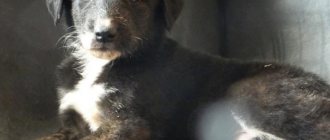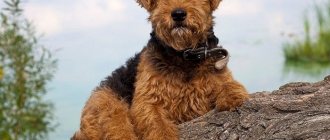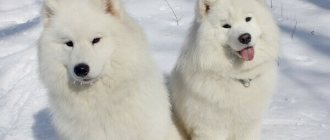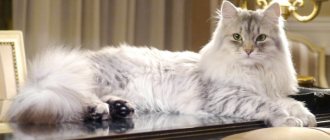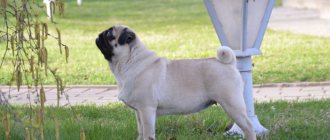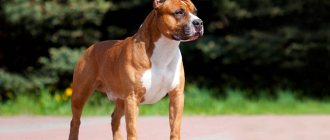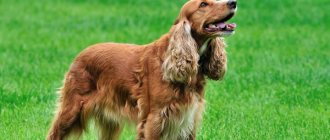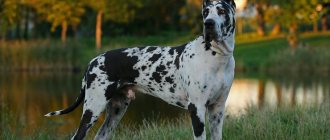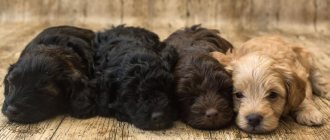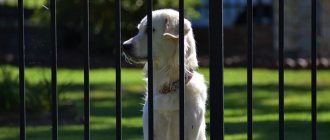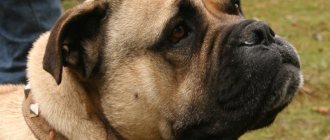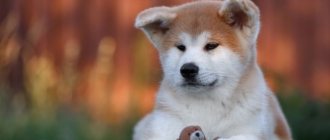Since ancient times, hunting dogs have lived side by side with people and are distinguished by amazing loyalty. This is how the Deerhound remains today, which belongs to the category of the oldest breeds bred by man. This is a strong, hardy dog, its other name is the deer greyhound, since the breed was originally designed for tracking artiodactyl animals, in particular deer.
Characteristics and breed standard
The Scottish Greyhound or Deerhound is a large, muscular, slender dog with a build similar to a Greyhound.
Height at withers: males minimum 76 cm, females minimum 71 cm Weight: 36.5-45.5 kg
Color: bluish-gray, fawn, sandy-red, shades of gray and brindle. White markings on the toes, chest, and tip of the tail are acceptable.
- The hair on the body is bristly, long (hair length is up to 10 cm). On the chest and belly the fur is softer; on the muzzle it creates a mustache and beard.
- Square or elongated body. The legs are long and straight.
- The head is elongated, but proportional to the body, with straight lines, with a smooth transition from the forehead to the muzzle, and strong jaws.
- Acceptable eye color is dark brown.
- The ears are small, hanging on cartilage, and set high. When the dog is calm, he pulls them back or presses them to his head.
- The color of the nose is black, and in fawn-blue dogs it is blue.
- The long tail is lowered when at rest, sometimes curved. When moving, the dog raises it, but not higher than the level of the back.
Description
The coat is mostly grey. There is an admixture of light or even completely white hair. On the face it is very hard, but closer to the back and belly it becomes soft and silky.
Weight is about 35-36 kg for girls and 44-45 for boys. Height from 70 and from 75 respectively.
This is a very athletic dog. Loves running and chasing. When hunting during a chase, it can reach speeds of up to 50 km/h. In the forest it is much smaller, since the dog is not agile and has a high risk of crashing into one of the trees. He always shows very high results in competitions and tournaments.
The average lifespan of a dog is about 10-12 years, but with proper care, a healthy diet and exercise, it can live for a year or more.
History of the breed
The first mention of these dogs in the chronicles of Scotland dates back to the 16th century; they were the favorite breed of the nobility. Although dogs similar in appearance lived before with the Picts, the oldest people of Scotland. Proof of this is the discovered ceramic items painted with images of hunting scenes with deerhounds or dogs similar to them.
There is an opinion that the Deerhound and the Irish Wolfhound are relatives, but whether this information is reliable is unknown.
They were bred for deer hunting and were valued for their intelligence, speed, and courage. A dog could single-handedly chase and kill a deer. The breed eventually spread throughout Great Britain and was in demand. Gradually, the number of deer in the forests decreased, and the deerhounds were replaced by greyhounds, hunters of hares.
In the middle of the 18th century, the breed was on the verge of extinction. In the 19th century, thanks to Archibald and Duncan MacNeil, deerhounds appeared at exhibitions and spread beyond Great Britain. In 1889, the Breed Club was created, and in 1892 the first exterior standard appeared. In the same year, the breed was officially recognized.
In the United States, where deer hunting was prohibited, deerhounds were used to bait coyotes. With the advent of firearms, dogs completely faded into the background, and the breed survived only thanks to rare enthusiasts and lovers of hunting with greyhounds.
Today the breed is widespread in England, where the aristocratic Reindeer Greyhound is still the dog of the nobility.
Choosing a puppy
In Russia and the CIS countries, the population of deerhounds is very small. Buying a puppy will be very difficult. For true lovers of the breed, it is better to think about buying a dog abroad, in England or Scotland, where the largest number of dogs and kennels are concentrated. Breeding is mainly aimed at maintaining working qualities.
When choosing a breeder, it is important to beware of scams. You should not immediately rush to an advertisement for the sale of Deerhound puppies at an attractive price, and especially not give money in advance to untrusted people. Puppies often have to be booked in advance. By the time of their birth, it is advisable to decide on the dog’s temperament, gender, and color. Babies can be calmer or more active, with less or more pronounced hunting instincts. Sometimes a litter contains puppies with soft fur. These dogs are unsuitable for exhibitions and further breeding, but the “defective” coat does not affect other qualities in any way.
Price
The price of a Deerhound puppy usually ranges from 40,000-70,000 rubles. A small Reindeer Greyhound costs about the same amount abroad, but to this amount must be added the costs of paperwork and transportation. The cheapest ones are puppies with various defects: soft coat, malocclusion, cryptorchidism and other plembracism. It is very, very rare to come across advertisements for the sale of Deerhounds without a pedigree.
Character and temperament
The Deerhound is a gentle and loyal, calm and dignified dog. He is noble and will not show aggression towards humans, although he is distrustful of strangers.
It is interesting that the reindeer hound manages to combine “duality” in itself: at home there is peace itself, but in the forest or on the street a hunting passion immediately awakens in it.
Pros:
- smart;
- loyal;
- calm;
- passionate hunter;
- not aggressive;
- patient;
- does not bark for any reason;
- loves children.
Minuses:
- does not protect;
- doesn't like to be alone;
- active;
- has a strong hunting instinct.
External signs
The general build of the Deerhound is similar to that of the Greyhound, only larger in size. The chest is deep, not too narrow, which indicates the dog has good lung capacity. The dog's neck is of medium length, strong to hold a deer. The head is wide, tapering towards the nose. The skull is flat, the forehead is slightly convex.
The ears are set high, folded back, soft to the touch. The eyes are medium sized, dark, dark brown, brown.
The forelegs are straight and dry. The hind limbs are widely spaced, which indicates their sufficient strength.
The coat is hard and rough on the body, limbs and neck. It is much softer on the chest and head. The ideal coat is tight-fitting, thick, and hard to the touch.
The color can be any. But bluish-gray is preferred. Sandy red and orange-brown are also highly prized.
Scottish Deerhound and man
Today it is more of a companion dog than a hunter, despite the hunting instincts that have not been lost. This is a pet that adores its owner’s family, sensitively capturing everyone’s mood. He does not need a lot of space; the Deerhound feels good in the city, provided it is given good walking. In the apartment he is calm and not prone to destruction. The dog loves comfort, so you need to make sure that he does not encroach on chairs and sofas. But he will be glad to have a soft bed where he can spend the whole day, blissfully and luxuriating.
The Deerhound is patient and loves children. He greets guests with dignity and may wag his tail a couple of times. This dog is not suitable as a guard.
The breed gets along with dogs and other pets.
Owner reviews
Sergey. I've always had hounds. I am a hunter myself and have a special love for hounds. I first saw a Deerhound with a companion abroad. Then I came on vacation. The dog's work captivated me! Powerful, fast, dexterous! I was excited - I really liked the dog. We had to wait a year and a half for the puppy - the breed is rare, the appointment was a year in advance. Now my dog is almost five - full of energy and always ready to work. I don’t advise anyone who dreams of a security guard to take it. But he is an excellent companion. He always senses the mood and knows when to be naughty and when it’s better to lie quietly in place. Very pleased with the breed.
Elena. My husband has been trying to persuade me to adopt a deerhound for a long time. I didn’t agree for a long time - the dog is large, my son is very small. I brought a three-month-old puppy in spite of. He turned out to be so nice that I couldn’t refuse. The dog is now almost three years old. My husband spends all hunting seasons with him (he works not only with deer, as it turns out), and the rest of the time the dog lives with us. We made him an insulated booth, but we don’t close the enclosure. We often let the dog into the house. They have a special understanding with the child. The Deerhound is very flexible and intelligent. Knows when to be naughty and when to be careful. I recommend it to active people. It is better not to take a dog into the apartment.
Maintenance and care
The Scottish Greyhound does not require much space, so it is convenient to keep it in a city apartment . Although in a private house with a local area.
The dog can live in a spacious enclosure or in a kennel, but if severe frosts strike, it is better to let the deerhound into the house. It is impossible to keep such a freedom-loving creature on a leash. In hot weather, the deerhound should be able to hide from the scorching sun under a canopy, since it is difficult for him in the sun .
Walks should be long, with active games and interesting activities. The greyhound is walked at least 2 times a day , one of the walks should last at least an hour. It is good if during this walk the dog can run freely or exercise with the owner, accompanying the owner during cycling or jogging.
An adult deerhound is fed 2 times a day in small portions. Prone to gaining excess weight, so pay close attention to how much food your dog eats.
He is not picky about food, but respects fresh lean meat and porridge.
The diet should be balanced: include sea fish, cereals, vegetables and fruits, and dairy products. The dog will not refuse premium dry food.
The Deerhound sheds a lot , so it is not recommended to let him lie on the bed or sofa. Brush your dog's coat daily to remove dead hair and prevent tangling and matting. Trimming is required periodically around the face and ears. Ears are cleaned as they become dirty, claws are trimmed if they do not grind down on the asphalt and ground.
What to feed: basic principles of feeding the Scottish Reindeer Greyhound
The Deerhound is not picky. The main thing is that the diet is balanced. A good solution may be to feed your greyhound with ready-made food. But their quality should be as high as possible.
Feeding giant deerhounds must be balanced.
Only super-premium and holistic food lines are suitable for the canine giant: Nutra Gold and Artemis, Belcando and Bosch, Arden Grange, Canidae and Acana, Wellness and Chicken Soup. You need to select them based on the age and weight of the dog. There are lines for puppies, juniors (teenagers) and adult dogs. The dosage is calculated according to the instructions printed on the packaging.
You can also feed your deer greyhound regular, self-cooked food. In addition to cereals, the diet must contain meat (beef tripe, offal), fermented milk products (cottage cheese is especially important for a growing body), and vitamin and mineral supplements.
Puppy diet from 2 to 3 months:
- beef – 250 gr.;
- cereal – 250 gr.;
- vegetables, fruits – 100 gr. (onions, garlic, legumes, corn, mushrooms and citrus fruits are prohibited);
- kefir – 0.5 l.;
- cottage cheese – 200 gr.;
- vitamin-mineral complex - according to instructions.
Every other day they give 100 grams. sea fish and soft-boiled egg (alternates). Dairy products should be a separate dish. You cannot mix them with porridge or vegetables.
Education and training
Even beginners have no problems with training, because this is an intelligent and understanding dog. The deerhound remembers commands quickly , but does not like being forced to repeat the same thing over and over again. So be patient and create fun things for your dog while training.
The reindeer greyhound is trained in coursing, running, bikejoring, and is taught to ride a bike or ride a horse.
Sometimes on walks, due to the hunting instinct, a deerhound runs away and begins to chase a cat, squirrel, or bird. This behavior must be stopped from puppyhood.
How to choose a pet
The Scottish Greyhound is a working breed, bred mainly by European kennels. The average cost of a puppy varies between 30-95 thousand rubles.
A breed-class Deerhound costs less, but a descendant of champions with show prospects will cost more. To make the right choice, when buying a puppy, it is advisable to pay attention to:
- availability of documents;
- compliance with the breed standard;
- health status;
- conditions of detention;
- behavioral features.
A purebred Deerhound puppy should have dark eyes, dry, strong paws and elastic, coarse fur of a characteristic color.
Health and life expectancy
Representatives of the breed are not long-lived, living on average 10 years .
Deerhounds are prone to the following diseases:
- portosystemic shunt (pathology of the blood vessels of the liver);
- hypothyroidism (pathology of the thyroid gland);
- stomach torsion;
- respiratory allergies;
- cardiomyopathy (heart pathology);
- cystinuria (hereditary kidney disease).
Dog market
The price of a Deerhound ranges from 30-70 thousand rubles. Depends on the constitution and the availability of a pedigree history document.
But Deerhound puppies of this type of dog are very difficult to find in the Russian Federation. There is no official registration of dog breeders yet. There are some fanciers, but under what conditions the puppies are sold, you will only find out when you meet them in person.
A private deerhound kennel is also rare in Russia, but it does exist if you search the Internet.
Sources
- https://lapkovskiy.ru/porody-sobak/shotlandskij-dirhaund-opisanie-i-harakteristiki-porody/
- https://www.moiasobaka.com/vse-o-porodah/bolshie/dirxaund.html
- https://catfishes.ru/dirxaund/
- https://usatiki.ru/dirhaund/
- https://givotniymir.ru/dirxaund-sobaka-opisanie-osobennosti-uxod-i-cena-dirxaunda/
- https://DogCentr.ru/porody-sobak/dirxaund.html
- https://porodadog.ru/porody-sobak/ohotnichi-sobaki/dirxaund.html
- https://zeleniymir.org/dirxaund/
[collapse]
Breed photo
A selection of photos of the Scottish Reindeer Greyhound.
Add a comment Cancel reply
